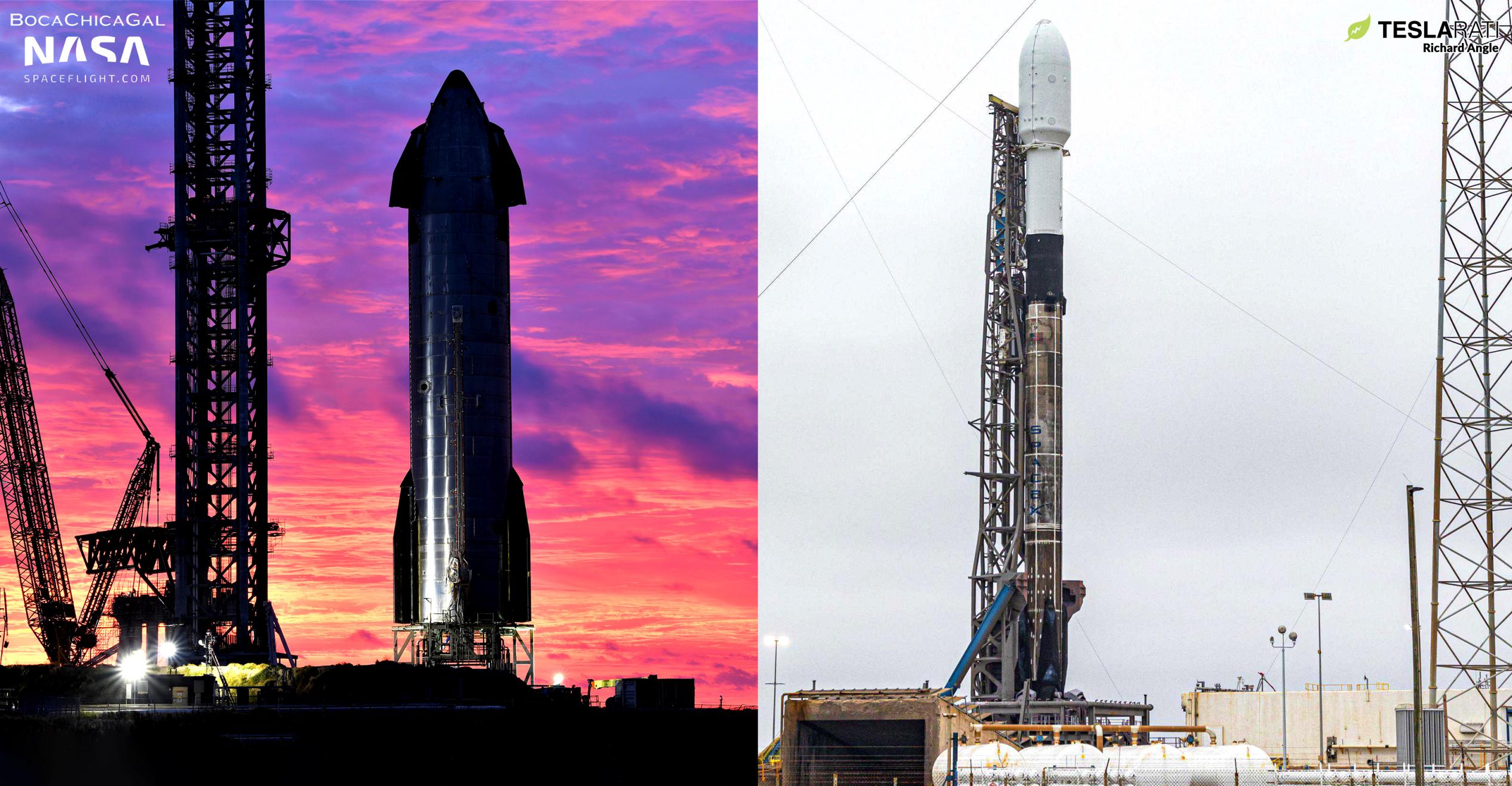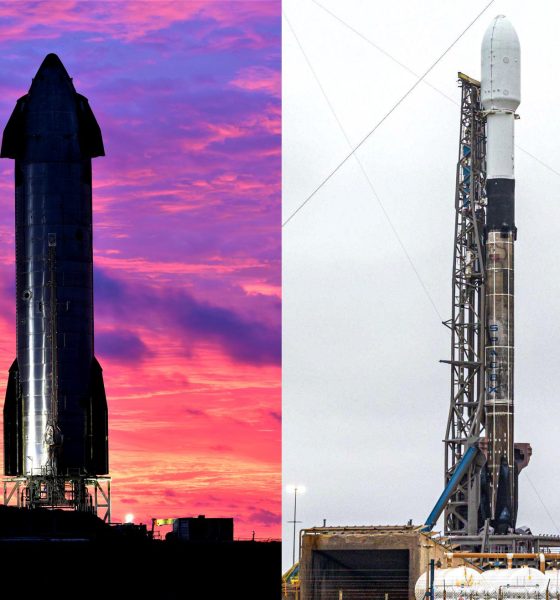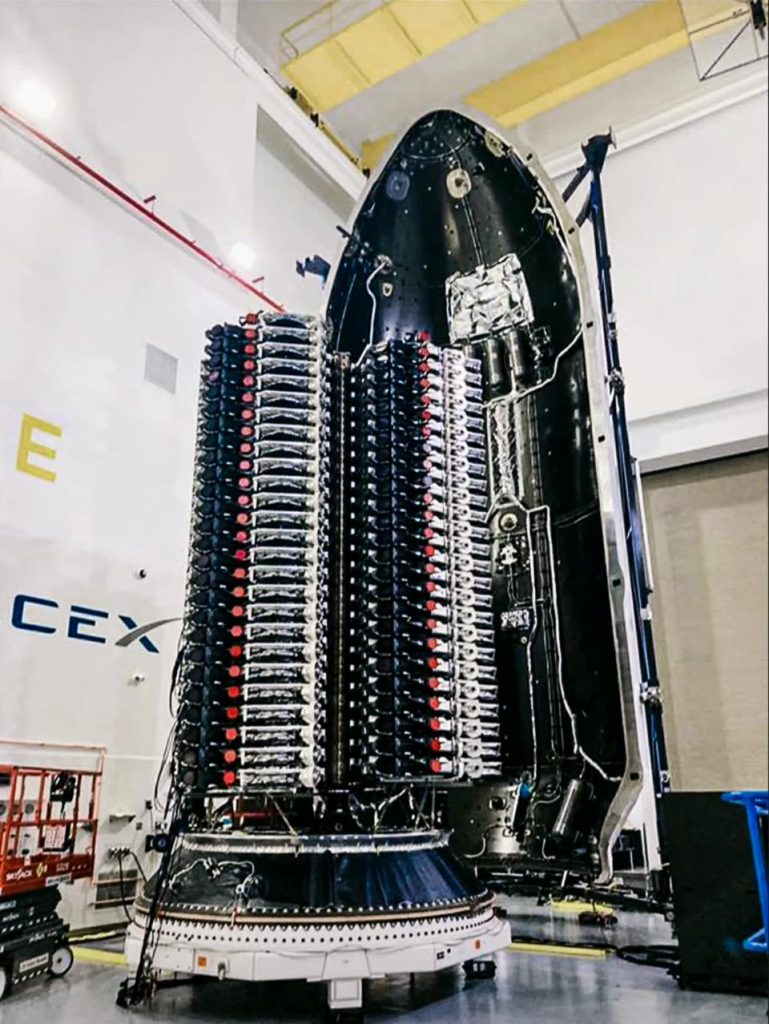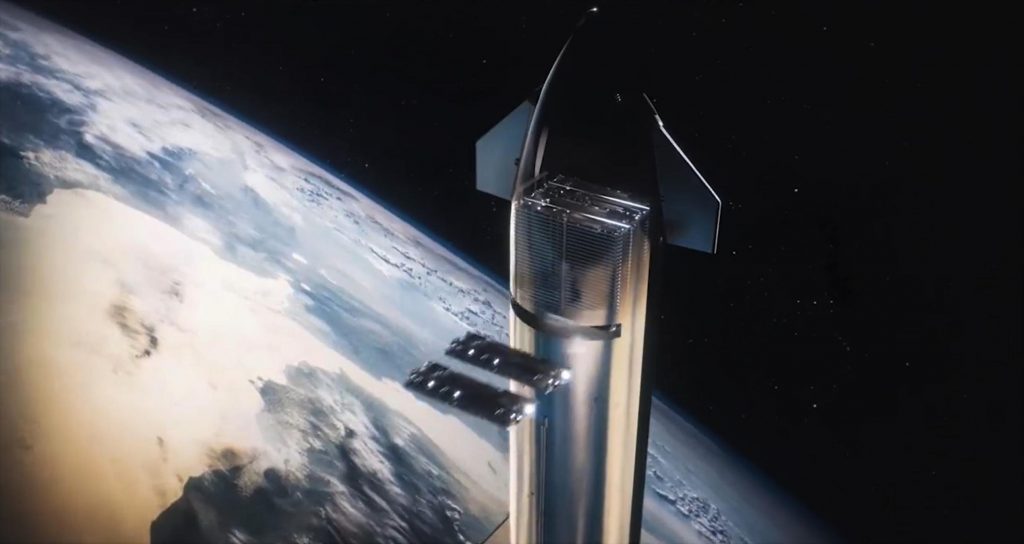

News
SpaceX tweaks Starlink Gen2 plans to add Falcon 9 launch option
SpaceX says it has revised plans for its next-generation Starlink Gen2 constellation to allow the upgraded satellites to launch on its workhorse Falcon 9 rocket in addition to Starship, a new and unproven vehicle.
Set to be the largest and most powerful rocket ever flown when it eventually debuts, SpaceX’s two-stage Starship launch vehicle is also intended to be fully reusable, theoretically slashing the cost of launching payloads into and beyond Earth orbit. Most importantly, SpaceX says that even in its fully-reusable configuration, Starship should be capable of launching up to 150 tons (~330,000 lb) to low Earth orbit (LEO) – nearly a magnitude more than Falcon 9. However, once said to be on track to debut as early as mid-2021 to early 2022, it’s no longer clear if Starship will be ready for regular Starlink launches anytime soon.
In August 2021, SpaceX failed a major Starlink Gen2 revision with the FCC that started the company along the path that led to now. That revision revealed plans to dramatically increase the size and capabilities of each Gen2 satellite, boosting their maximum throughput from about 50 gigabits per second (Gbps) to ~150 Gbps. Just as importantly, SpaceX’s August 2021 modification made it clear that the company would prefer to launch the entire constellation with Starship, although it included an alternative constellation design that would lend itself better to Falcon 9 launches.
In January 2022, SpaceX chose to solely pursue the constellation optimized for Starship, strongly indicating that the company believed the rocket would be ready to support Starlink launches in the near future – or at least around the same time the constellation receives its Gen2 FCC license. With the benefit of technical Starlink Gen2 satellite details and renders provided by SpaceX and CEO Elon Musk in Q2 2022, a single Starship Gen2 launch using the current satellite and rocket designs and carrying 54 satellites could potentially deploy around 7-8 times more usable bandwidth than a Falcon 9 with Starlink V1.5, meaning that Starship could achieve similar deployment results with just a few launches per year.


In theory, that makes it at least somewhat easier for Starship to make a major impact even as SpaceX works to ramp up the brand-new rocket’s launch cadence, a task that has almost always taken several years.
However, additional changes made to its Starlink Gen2 FCC license application in August 2022 suggest that SpaceX has at least partially tempered that all-in bet on Starship. The most important modification: developing a different Starlink Gen2 satellite variant that will be optimized to fit inside Falcon 9’s much smaller payload fairing. According to SpaceX, despite the seemingly major form-factor changes required to make Gen2 fit, Starship and Falcon 9-optimized satellites will still be “technically identical.”
The implication is that the satellites launched on Falcon 9 will still offer the same performance as those launched on Starship, albeit in a different form factor. Nonetheless, the only thing SpaceX guarantees in the document is that the Falcon 9-launched Gen2 satellites won’t be more powerful than those launched on Starship, presumably preserving the applicability of existing analysis in the current Starlink Gen2 application. It’s thus possible that Falcon 9-optimized Starlink Gen2 satellites will have to sacrifice some of their performance relative to the unconstrained Starship-optimized variant.
With a usable diameter of 4.6 meters (~15 ft), Falcon 9’s payload fairing is about 50% narrower than the payload bay present on early Starship prototypes. Without a major redesign, Starlink Gen2 satellites optimized for Falcon 9 will likely need to sit vertically inside the fairing, the standard version of which stands 6.7 meters (~22 ft) tall before its conical tip begins curving inwards. Weighing about 1.25 tons (~2750 lb) and measuring 7 meters (~23 ft) long, Starlink Gen2’s design may only need a few moderate tweaks to fit on Falcon 9, but they’ll have to be stacked vertically instead of horizontally. Falcon 9’s established performance of roughly 16.5 tons (payload adapter included) to LEO means that the rocket will be limited to around 12 or 13 Gen2 satellites per launch, however, making the task somewhat easier.
If SpaceX can squeeze that many Starlink Gen2 satellites inside of Falcon 9’s existing reusable fairing, it could still boost the efficiency (total bandwidth per launch) of each Starlink mission by ~50% relative to the same rocket carrying 50-60 Starlink V1.5 satellites. It’s no surprise, then, that SpaceX appears to be doing everything it can to begin launching Starlink Gen2 as quickly as possible, whether or not Starship is ready to help.

News
Tesla (TSLA) receives “Buy” rating and $551 PT from Canaccord Genuity
He also maintained a “Buy” rating for TSLA stock over the company’s improving long-term outlook, which is driven by autonomy and robotics.

Canaccord Genuity analyst George Gianarikas raised his Tesla (NASDAQ:TSLA) price target from $482 to $551. He also maintained a “Buy” rating for TSLA stock over the company’s improving long-term outlook, which is driven by autonomy and robotics.
The analyst’s updated note
Gianarikas lowered his 4Q25 delivery estimates but pointed to several positive factors in the Tesla story. He noted that EV adoption in emerging markets is gaining pace, and progress in FSD and the Robotaxi rollout in 2026 represent major upside drivers. Further progress in the Optimus program next year could also add more momentum for the electric vehicle maker.
“Overall, yes, 4Q25 delivery expectations are being revised lower. However, the reset in the US EV market is laying the groundwork for a more durable and attractive long-term demand environment.
“At the same time, EV penetration in emerging markets is accelerating, reinforcing Tesla’s potential multi‑year growth runway beyond the US. Global progress in FSD and the anticipated rollout of a larger robotaxi fleet in 2026 are increasingly important components of the Tesla equity story and could provide sentiment tailwinds,” the analyst wrote.
Tesla’s busy 2026
The upcoming year would be a busy one for Tesla, considering the company’s plans and targets. The autonomous two-seat Cybercab has been confirmed to start production sometime in Q2 2026, as per Elon Musk during the 2025 Annual Shareholder Meeting.
Apart from this, Tesla is also expected to unveil the next-generation Roadster on April 1, 2026. Tesla is also expected to start high-volume production of the Tesla Semi in Nevada next year.
Apart from vehicle launches, Tesla has expressed its intentions to significantly ramp the rollout of FSD to several regions worldwide, such as Europe. Plans are also underway to launch more Robotaxi networks in several more key areas across the United States.
News
Waymo sues Santa Monica over order to halt overnight charging sessions
In its complaint, Waymo argued that its self-driving cars’ operations do not constitute a public nuisance, and compliance with the city’s order would cause the company irreparable harm.

Waymo has filed a lawsuit against the City of Santa Monica in Los Angeles County Superior Court, seeking to block an order that requires the company to cease overnight charging at two facilities.
In its complaint, Waymo argued that its self-driving cars’ operations do not constitute a public nuisance, and compliance with the city’s order would cause the company irreparable harm.
Nuisance claims
As noted in a report from the Los Angeles Times, Waymo’s two charging sites at Euclid Street and Broadway have operated for about a year, supporting the company’s growing fleet with round-the-clock activity. Unfortunately, this has also resulted in residents in the area reportedly being unable to sleep due to incessant beeping from self-driving taxis that are moving in and out of the charging stations around the clock.
Frustrated residents have protested against the Waymos by blocking the vehicles’ paths, placing cones, and “stacking” cars to create backups. This has also resulted in multiple calls to the police.
Last month, the city issued an order to Waymo and its charging partner, Voltera, to cease overnight operations at the charging locations, stating that the self-driving vehicles’ activities at night were a public nuisance. A December 15 meeting yielded no agreement on mitigations like software rerouting. Waymo proposed changes, but the city reportedly insisted that nothing would satisfy the irate residents.
“We are disappointed that the City has chosen an adversarial path over a collaborative one. The City’s position has been to insist that no actions taken or proposed by Waymo would satisfy the complaining neighbors and therefore must be deemed insufficient,” a Waymo spokesperson stated.
Waymo pushes back
In its legal complaint, Waymo stated that its “activities at the Broadway Facilities do not constitute a public nuisance.” The company also noted that it “faces imminent and irreparable harm to its operations, employees, and customers” from the city’s order. The suit also stated that the city was fully aware that the Voltera charging sites would be operating around the clock to support Waymo’s self-driving taxis.
The company highlighted over one million trips in Santa Monica since launch, with more than 50,000 rides starting or ending there in November alone. Waymo also criticized the city for adopting a contentious strategy against businesses.
“The City of Santa Monica’s recent actions are inconsistent with its stated goal of attracting investment. At a time when the City faces a serious fiscal crisis, officials are choosing to obstruct properly permitted investment rather than fostering a ‘ready for business’ environment,” Waymo stated.
News
Tesla FSD v14.2.2 is getting rave reviews from drivers
So far, early testers have reported buttery-smooth drives with confident performance, even at night or on twisty roads.

Tesla Full Self-Driving (Supervised) v14.2.2 is receiving positive reviews from owners, with several drivers praising the build’s lack of hesitation during lane changes and its smoother decision-making, among others.
The update, which started rolling out on Monday, also adds features like dynamic arrival pin adjustment. So far, early testers have reported buttery-smooth drives with confident performance, even at night or on twisty roads.
Owners highlight major improvements
Longtime Tesla owner and FSD user @BLKMDL3 shared a detailed 10-hour impression of FSD v14.2.2, noting that the system exhibited “zero lane change hesitation” and “extremely refined” lane choices. He praised Mad Max mode’s performance, stellar parking in locations including ticket dispensers, and impressive canyon runs even in dark conditions.
Fellow FSD user Dan Burkland reported an hour of FSD v14.2.2’s nighttime driving with “zero hesitations” and “buttery smooth” confidence reminiscent of Robotaxi rides in areas such as Austin, Texas. Veteran FSD user Whole Mars Catalog also demonstrated voice navigation via Grok, while Tesla owner Devin Olsen completed a nearly two-hour drive with FSD v14.2.2 in heavy traffic and rain with strong performance.
Closer to unsupervised
FSD has been receiving rave reviews, even from Tesla’s competitors. Xpeng CEO He Xiaopeng, for one, offered fresh praise for FSD v14.2 after visiting Silicon Valley. Following extended test drives of Tesla vehicles running the latest FSD software, He stated that the system has made major strides, reinforcing his view that Tesla’s approach to autonomy is indeed the proper path towards autonomy.
According to He, Tesla’s FSD has evolved from a smooth Level 2 advanced driver assistance system into what he described as a “near-Level 4” experience in terms of capabilities. While acknowledging that areas of improvement are still present, the Xpeng CEO stated that FSD’s current iteration significantly surpasses last year’s capabilities. He also reiterated his belief that Tesla’s strategy of using the same autonomous software and hardware architecture across private vehicles and robotaxis is the right long-term approach, as it would allow users to bypass intermediate autonomy stages and move closer to Level 4 functionality.








